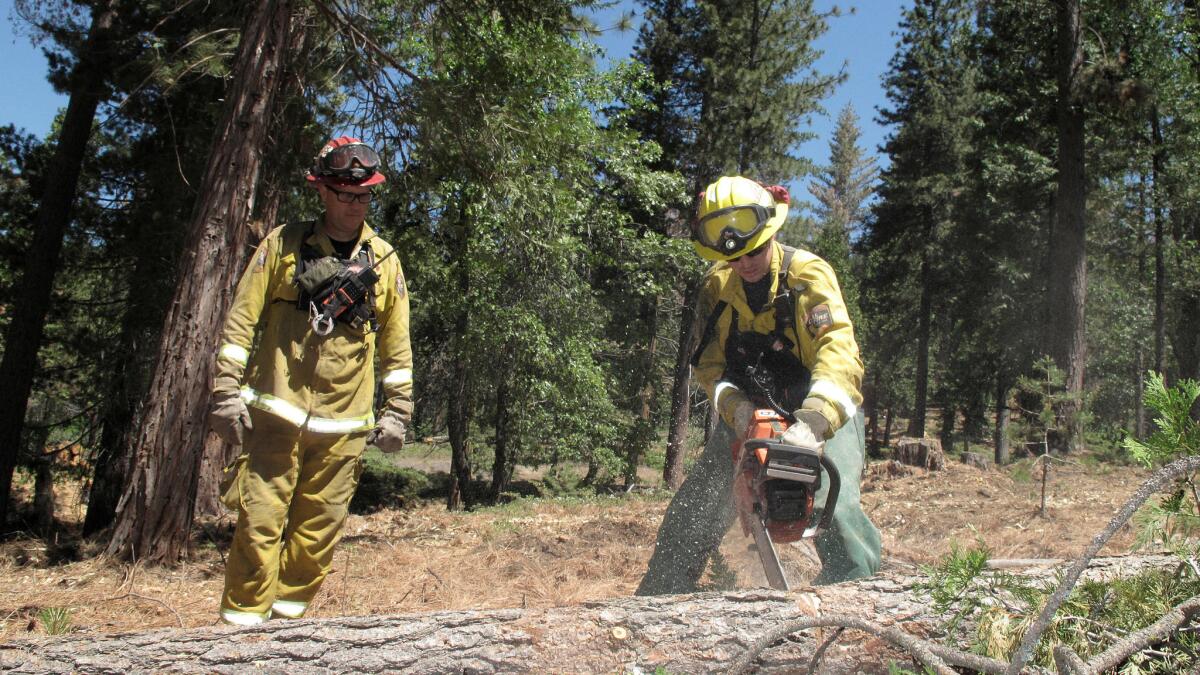Op-Ed: Trees are dying in the Sierra but the forests aren’t

The trees are dying. The forests are not.
This distinction is getting lost in all the angst over the tree die-off in the central Sierra, coastal ranges and other forests of California. Players ranging from the Forest Service to CalFire to Sen. Dianne Feinstein and other public officials are ignoring this key fact in their rush to do something, anything, about the dying trees.
Feinstein, in a recent letter to Agriculture Secretary Tom Vilsack, urged him to transfer the tidy sum of $38 million to the Forest Service so that it could immediately harvest thousands of red-needled pine and other dead trees in “high hazard” areas in the Sequoia, Sierra and Stanislaus national forests. “After five years of historic drought,” she argued, “which has led to the death of an estimated 66 million trees in California alone, my state and its people face a heightened and potentially catastrophic risk of wildfire this year and for years to come.”
And that request is but a drop in the bucket, according to Feinstein. In a previous letter to the Office of Management and Budget, she said federal and state officials calculated that 5.5 million of California’s 66 million dead trees posed “a particular threat to public safety and must be removed as quickly as possible.” The Forest Service’s estimate to harvest just its portion of the threatening trees (3.7 million) was $562 million. There is no way the Obama administration is going to ask for, or that Congress would provide, half-a-billion dollars for such an effort in a single state.
The calculation that dead trees equals catastrophe could not be more wrong.
But really, that would be OK. Because the calculation that dead trees equals catastrophe could not be more wrong.
Although the attention-getting figure of 66 million dead trees (or “snags”) — widely publicized this summer — seems like a lot, the figure shrinks when set in its wider, arboreal context. As Doug Bevington of Environment Now has reported, there are 33 million forested acres in the state, meaning that the recent pulse of tree mortality on average has increased the number of dead trees by a mere two snags per acre: “To put that number in perspective,” Bevington wrote, “forest animals that live in snags generally need at least four to eight snags per acre to provide sufficient habitat and some species require even more snags.” In short, viewed ecologically, California’s forests suffer from a deficit of dead trees, not a surfeit.
Besides, dead trees are not bereft of life. They are essential to the survival of such cavity-nesting species as the endangered California spotted owl and the increasingly rare black-backed woodpecker. Ditto for the little-seen Pacific fisher, a forest-dweller related to the weasel whose diet in part consists of small mammals that take advantage of snag ecosystems. A host of other organisms feast on dead trees upright or fallen, so that what on the surface might seem like a patch of ghost forest in fact is a biodiversity hot spot, a teeming terrain.
While countless living things thrive off the dead trees, fire does not. This seems counter-intuitive, especially when firefighters tell The Times “it’s going to be much harder for us to stop a fire in these dead forests, as opposed to when they were alive.” In fact, fire-ecology research has demonstrated that snags do not burn with a greater intensity than green trees, and their presence does not accelerate the spread of fire. Nor does it increase the chance of wildfire. Even the state’s firefighter-in-chief, CalFire Director Ken Pimlott, agrees with the “emerging body of science that has found dead trees don’t significantly increase the likelihood of wildfires.”
Don’t get me wrong: There are legitimate reasons to log some snags located in portions of the wildland-urban interface to ensure public safety and protect vital infrastructure. It’s entirely possible that Feinstein’s requested $38 million transfer for logging high hazard areas would be a good investment. But slicking off 5.5 million trees — or even just the 3.7 million proposed for harvest in the national forests — cannot be defended in terms of science or policy. And it would break the bank.
Instead, those kinds of harvest numbers sound disconcertingly like political logrolling. In this case, agencies and their allies may be spreading fear of imminent, ecosystemic collapse that can only be averted via a massive infusion of tax dollars that would also prop up the timber and biomass industries. (The latter turns board-feet into kilowatts, a process as inefficient and C02-spewing as coal, accelerating the planet’s warming. Not climate-smart.)
So let’s take nature seriously. Even those who mourn the loss of the iconic, pine-scented uninterrupted sweep of green trees in the Sierra should remember that the “death” we perceive in California’s forests presages their regeneration. John Muir, the troubadour of all things Sierra, said as much in 1878. After years of field research, he concluded that sequoia regrowth depended on natural disturbance. Erosion and floods, “some pawing of squirrel or bear,” and the “fall of old trees” cleared the way for successive generations to flourish. Even fire,“the great destroyer of tree life” prepares “bare virgin ground … one of the conditions essential for [sequoias’] growth from the seed.” Muir’s penetrating insight was controversial in the late 19th century, but it shouldn’t be today.
The trees are dying. The forests are not.
Char Miller is a professor of environmental analysis at Pomona College and is the author of the just-published “Not So Golden State: Sustainability vs. the California Dream.”
Follow the Opinion section on Twitter @latimesopinion and Facebook
More to Read
A cure for the common opinion
Get thought-provoking perspectives with our weekly newsletter.
You may occasionally receive promotional content from the Los Angeles Times.










